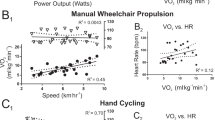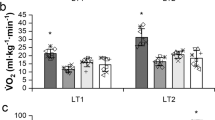Abstract
The purpose of this investigation was to examine the use of subjective rating of perceived exertion (RPE) as a tool to self-regulate the intensity of wheelchair propulsive exercise in individuals with tetraplegia. Eight motor complete tetraplegic (C5/6 and below; ASIA Impairment Scale = A) participants completed a submaximal incremental exercise test followed by a graded exercise test to exhaustion to determine peak oxygen uptake (\( \dot{V}O_{{ 2 {\text{peak}}}} \)) on a wheelchair ergometer. On a separate day, a 20-min exercise bout was completed at an individualised imposed power output (PO) equating to 70 % of \( \dot{V}O_{{ 2 {\text{peak}}}} \). On a third occasion, participants were instructed to maintain a workload equivalent to the average RPE for the 20-min imposed condition. \( \dot{V}O_{2} \), heart rate (HR) and PO were measured at 1-min intervals and blood lactate concentration [BLa−] was measured at 0, 10 and 20 min. No differences (P > 0.17) were found between mean \( \dot{V}O_{2} \), % \( \dot{V}O_{{ 2 {\text{peak}}}} \), HR, % HRpeak, [BLa−], velocity or PO between the imposed and RPE-regulated trials. No significant (P > 0.05) time-by-trial interaction was present for \( \dot{V}O_{2} \) data. A significant interaction (P < 0.001) for the PO data represented a trend for an increase in PO from 10 min to the end of exercise during the RPE-regulated condition. However, post hoc analysis revealed none of the differences in PO across time were significant (P > 0.05). In conclusion, these findings suggest that RPE can be an effective tool for self-regulating 20 min of wheelchair propulsion in a group of trained participants with tetraplegia who are experienced in wheelchair propulsion.


Similar content being viewed by others
References
Al-Rahamneh H, Eston R (2011a) The validity of predicting peak oxygen uptake from a perceptually guided graded exercise test during arm exercise in paraplegic individuals. Spinal Cord 49:430–434
Al-Rahamneh HQ, Eston RG (2011b) Prediction of peak oxygen consumption from the ratings of perceived exertion during a graded exercise test and ramp exercise test in able-bodied participants and paraplegic persons. Arch Phys Med Rehabil 92:277–283
Al-Rahamneh HQ, Faulkner JA, Byrne C, Eston RG (2010) Relationship between perceived exertion and physiologic markers during arm exercise with able-bodied participants and participants with poliomyelitis. Arch Phys Med Rehabil 91:273–277
American College of Sports Medicine, Thompson WR, Gordon NF, Pescatello LS (2010) ACSM’s guidelines for exercise testing and prescription, 7th edn. Wolters Kluwer/Lippincott Williams and Wilkins, Baltimore
Borg G (1998) Borg’s perceived exertion and pain scales. Human Kinetics Publishers, Champaign
Buckley JP, Eston RG, Sim J (2000) Ratings of perceived exertion in braille: validity and reliability in production mode. Br J Sports Med 34:297–302
Dunbar CC, Robertson R, Baun R et al (1992) The validity of regulating exercise intensity by ratings of perceived exertion. Med Sci Sports Exerc 24:94–99
Eston R, Brodie D (1986) Responses to arm and leg ergometry. Br J Sports Med 20:4–6
Eston R, Williams J (1988) Reliability of ratings of perceived effort regulation of exercise intensity. Br J Sports Med 22:153–155
Eston RG, Davies BL, Williams JG (1987) Use of perceived effort ratings to control exercise intensity in young healthy adults. Eur J Appl Physiol Occup Physiol 56:222–224
Faulkner J, Eston R (2007) Overall and peripheral ratings of perceived exertion during a graded exercise test to volitional exhaustion in individuals of high and low fitness. Eur J Appl Physiol 101:613–620
Faulkner J, Eston RG (2008) Perceived exertion research in the 21st century: developments, reflections and questions for the future. J Exerc Sci Fit 6:26–32
Faulkner J, Parfitt G, Eston R (2007) Prediction of maximal oxygen uptake from the ratings of perceived exertion and heart rate during a perceptually-regulated sub-maximal exercise test in active and sedentary participants. Eur J Appl Physiol 101:397–407
Figoni S (1993) Exercise responses and quadriplegia. Med Sci Sports Exerc 25:433–441
Goosey-Tolfrey V (2008) The disabled athlete. In: Winter E, Jones A, Davison, R, Bromley P, Mercer T (eds) BASES sport and exercise physiology testing guidelines, vol 1: sport testing, Routledge, Oxford, pp 359–367
Goosey-Tolfrey V, Lenton J, Goddard J, Oldfield V, Tolfrey K, Eston R (2010) Regulating intensity using perceived exertion in spinal cord-injured participants. Med Sci Sports Exerc 42:608–613
Haisma J, Van der Woude L, Stam H, Bergen M, Sluis T, Bussmann J (2006) Physical capacity in wheelchair-dependent persons with a spinal cord injury: a critical review of the literature. Spinal Cord 44:642–652
Janssen TWJ and Hopman MTE (2005) Spinal cord injury. In: Skinner JS (eds) Exercise testing and exercise prescription for special cases: theoretical basis and clinical application, Lippincott Williams and Wilkins, Baltimore, pp 203–219
Kang J, Hoffman JR, Walker H, Chaloupka EC, Utter AC (2003) Regulating intensity using perceived exertion during extended exercise periods. Eur J Appl Physiol 89:475–482
Kang J, Chaloupka EC, Biren GB, Mastrangelo MA, Hoffman JR (2009) Regulating intensity using perceived exertion: effect of exercise duration. Eur J Appl Physiol 105:445–451
Kirshblum S, Burns S, Biering-Sorensen F, Donovan W, Graves D, Jha A, Johansen M et al (2011) International standards for neurological classification of spinal cord injury. J Spinal Cord Med 34:535–546
Lambrick DM, Faulkner JA, Rowlands AV, Eston RG (2009) Prediction of maximal oxygen uptake from submaximal ratings of perceived exertion and heart rate during a continuous exercise test: the efficacy of RPE 13. Eur J Appl Physiol 107:1–9
Leicht CA, Bishop NC, Goosey-Tolfrey VL (2011) Submaximal exercise responses in tetraplegic, paraplegic and non-spinal cord injured elite wheelchair athletes. Scand J Med Sci Sports. doi:10.1111/j.1600-0838.2011.01328
Lenton JP, Fowler NE, van Der Woude L, Goosey-Tolfrey VL (2008) Wheelchair propulsion: effects of experience and push strategy on efficiency and perceived exertion. Appl Physiol Nutr Metab 33:870–879
Lewis JE, Nash MS, Hamm LF, Martins SC, Groah SL (2007) The relationship between perceived exertion and physiologic indicators of stress during graded arm exercise in persons with spinal cord injuries. Arch Phys Med Rehabil 88:1205–1211
Müller G, Odermatt P, Perret C (2004) A new test to improve the training quality of wheelchair racing athletes. Spinal Cord 42:585–590
Noble BJ (1982) Clinical applications of perceived exertion. Med Sci Sports Exerc 14:406–411
Pandolf KB, Billings DS, Drolet LL, Pimental NA, Sawka MN (1984) Differentiated ratings of perceived exertion and various physiological responses during prolonged upper and lower body exercise. Eur J Appl Physiol Occup Physiol 53:5–11
Sawka MN, Glaser R, Laubach LL, Al-Samkari O, Suryaprasad AG (1981) Wheelchair exercise performance of the young, middle-aged, and elderly. J Appl Physiol 50:824–828
Theisen D, Francaux M, Fayt A, Sturbois X (1996) A new procedure to determine external power output during handrim wheelchair propulsion on a roller ergometer: a reliability study. Int J Sports Med 17:564–571
Tucker R (2009) The anticipatory regulation of performance: the physiological basis for pacing strategies and the development of a perception-based model for exercise performance. Br J Sports Med 43:392–400
Tucker R, Noakes TD (2009) The physiological regulation of pacing strategy during exercise: a critical review. Br J Sports Med 43:e1
Valent L, Dallmeijer A, Houdijk H, Talsma E, van der Woude LHV (2007a) The effects of upper body exercise on the physical capacity of people with a spinal cord injury: a systematic review. Clin Rehabil 21:315–330
Valent L, Dallmeijer A, Houdijk H, Slootman J, Janssen T, Hollander A (2007b) The individual relationship between heart rate and oxygen uptake in people with a tetraplegia during exercise. Spinal Cord 45:104–111
van der Woude LHV, de Groot S, Hollander SP, van Ingen Schenau GJ, Rozendal RH (1986) Wheelchair ergonomics and physiological testing of prototypes. Ergonomics 29:1561–1573
Acknowledgments
No direct funding was received for this work. The authors would like to thank John Lenton and Dr. Barry Mason for their help and expertise with the laboratory testing. Thanks also go to the Great Britain Wheelchair Rugby Association for their support and the participants who volunteered to take part in this study.
Author information
Authors and Affiliations
Corresponding author
Additional information
Communicated by Dag Linnarsson.
Rights and permissions
About this article
Cite this article
Paulson, T.A.W., Bishop, N.C., Leicht, C.A. et al. Perceived exertion as a tool to self-regulate exercise in individuals with tetraplegia. Eur J Appl Physiol 113, 201–209 (2013). https://doi.org/10.1007/s00421-012-2426-5
Received:
Accepted:
Published:
Issue Date:
DOI: https://doi.org/10.1007/s00421-012-2426-5




